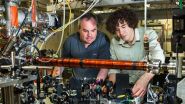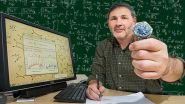The new TB-Profiler tool, developed by a team of scientists led by Dr Taane Clark at the London School of Hygiene & Tropical Medicine, analyses and interprets genome sequence data to predict resistance to 11 drugs used for the treatment of TB. This rapid tool only takes a few minutes and means that sequence data can now be used without delay. Importantly, it also removes dependence on specialised bioinformatics skills that are not readily available in clinical settings. Data on how the tool works is published in open access journal Genome Medicine.
Speeding up the process to find appropriate drugs when treating a patient with drug-resistant TB improves the likelihood of cure. By enabling the optimum course of treatment to be selected without delay, toxic drugs found to be ineffective because of resistance can be disregarded, relieving patients of damaging, unpleasant, and often long-lasting side effects.
Researchers say the TB-Profiler tool - available at tbdr.lshtm.ac.uk - will aid control of drug resistant TB, the emergence of which currently threatens to derail global efforts to control the disease. The World Health Organisation estimates that 5% of the world's 11 million TB cases have multi drug-resistance disease (MDR-TB), with approximately 480,000 new MDR-TB cases arising in 2013 and 210,000 deaths.
The TB-Profiler was developed using global data and refers to a library of 1,325 mutations to M. tuberculosis (the bacteria that causes TB), making the tool the most comprehensive and accurate data source to date.
Dr Taane Clark, Reader in Genetic Epidemiology and Statistical Genomics, said: "Sequencing already assists patient management for a number of conditions such as HIV, but now that it is possible to sequence M. tuberculosis from sputum from suspected multi-drug resistance patients means it has a role in the management of tuberculosis. We have developed a prototype to guide treatment of patients with drug resistant disease, where personalised medicine and treatment offers improved rates of cure."
Traditional lab-based methods of determining resistance involve growing the bacteria to see if it survives the drug, a process that can take weeks and sometimes months, and requires stringent safety measures to protect the laboratory personnel.
The researchers highlight that their research demonstrates the potential of whole genome sequencing to increase the accuracy of molecular tests for resistance, with improved sensitivity and specificity. The tool also provides data on the genotype of the bacteria which can be used in epidemiological studies and by public health experts to track chains of disease transmission.
Co-author Dr Ruth McNerney of TB Alert added: "This is a welcome step forward in our battle against drug resistance. It is now time to take sequencing out of the research lab and into the clinic. Patients with drug resistant disease have to endure many months of treatment with toxic drugs with no guarantee of success. Personalised treatment will increase their chances of survival while minimising the horrible side effects."
INFORMATION:
For more information or to request interviews with Dr Taane Clarke please contact the press office at the London School of Hygiene & Tropical Medicine: press@lshtm.ac.uk or +44 (0)20 7927 2802.
For interview with Dr Ruth McNerney: Ruth.Mcnerney@gmail.com or +44 (0)7557020305 or +27 (0)78358815 (South Africa)
Notes to Editors
Francesc Coll, Ruth McNerney, Mark D Preston, José Afonso Guerra-Assunção, Andrew Warry, Grant Hill-Cawthorne, Kim Mallard, Mridul Nair, Anabela Miranda, Adriana Alves, João Perdigão, Miguel Viveiros, Isabel Portugal, Zahra Hasan, Rumina Hasan, Judith R Glynn, Nigel Martin, Arnab Pain, Taane G Clark. Rapid determination of anti-tuberculosis drug resistance from whole-genome sequences. Genome Medicine. DOI: 10.1186/s13073-015-0164-0 http://genomemedicine.com/content/7/1/51
The emergence of TB that cannot be cured using the standard cocktail of four antibiotics is threatening to disrupt control of the disease on a global scale. The World Health Organisation estimates that 5% of the world's 11 million TB cases have multi drug-resistance disease (MDR-TB) and that 480,000 new cases arose during 2013 alone. Of those approximately 9% have extensively resistant tuberculosis (XDR-TB) where, in addition to resistance to at least both of the major first line drugs (isoniazid and rifampicin), they also have resistance to two classes of second line drugs used to treat MDR-TB (the fluoroquinolones and the injectable drugs, amikacin, kanamycin, or capreomycin). Further details: http://www.who.int/tb/publications/global_report/en/
It is a global problem as XDR-TB has been reported in at least 100 countries but the problem is most acute in Eastern Europe, the Russian Federation, South Africa and parts of India and China. Incurable TB, resistant to all the available drugs tested has been reported in several countries (including India, South Africa, Iran and Italy).
TB is an aerosol borne disease that spreads through the air. If not treated with effective drugs patients can remain infectious, coughing out the drug resistant bacteria until they die.
Treatment for patients with drug resistant tuberculosis is prolonged (years), expensive and outcomes are poor. The drugs used are toxic and poorly tolerated, adverse events are common and may be severe and irreversible. Common side effects include nausea, depression, liver damage, nerve damage and hearing loss.
Resistance is mainly caused by mutations in the genome of the bacteria that cause the disease, Mycobacterium tuberculosis. Mutations occur naturally in genes but are rare and usually of no significance but if patients have been exposed to sub-standard treatment instead of effective therapy with multiple drugs the mutated bacteria can survive and multiply and drug resistance emerges. Once resistant the bacteria can spread to other people and cause drug resistant disease.
The large number of drugs used to treat TB means that detecting the mutations that cause resistance is a complex business as there are many genes involved and hundreds of sites in the genome that need to be examined. Whole genome sequencing offers the most effective way of detecting resistance mutations but although the sequencing technologies have advanced rapidly and desk top analysers are now available for use in hospitals the vast amounts of data generated has previously needed analysis by expert bioinformaticians, a process that often delays results by weeks.
Whole genome sequencing of TB is used for managing patients with drug resistant TB in London. Further details: http://jcm.asm.org/content/early/2015/02/06/JCM.02993-14
About the London School of Hygiene & Tropical Medicine
The London School of Hygiene & Tropical Medicine is a world-leading centre for research and postgraduate education in public and global health, with 3,900 students and more than 1,000 staff working in over 100 countries. The School is one of the highest-rated research institutions in the UK, and among the world's leading schools in public and global health. Our mission is to improve health and health equity in the UK and worldwide; working in partnership to achieve excellence in public and global health research, education and translation of knowledge into policy and practice. http://www.lshtm.ac.uk

